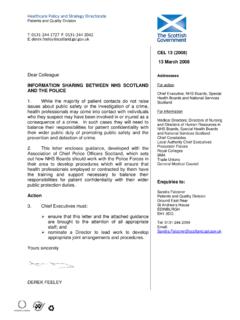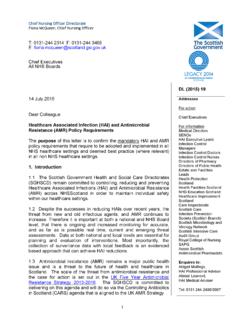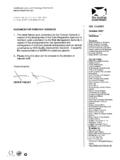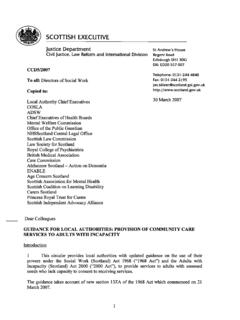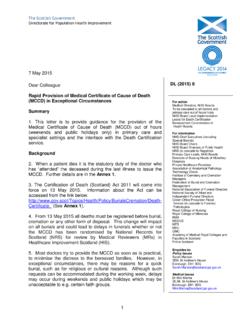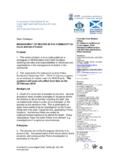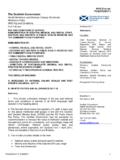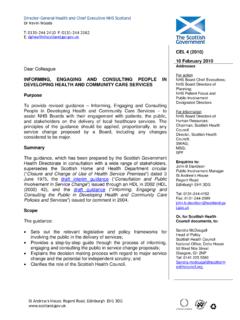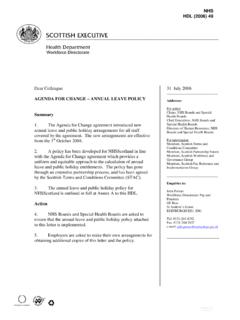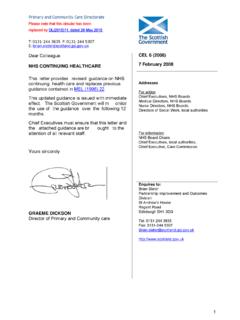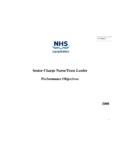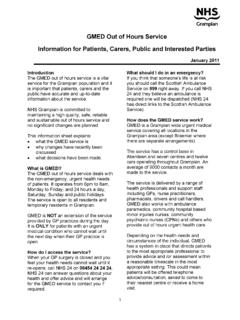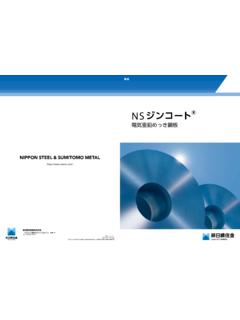Transcription of The Quality Unit abcdefghijklmnopqrstu ... - sehd.scot.nhs.uk
1 A b c d e f g h i j k l m n o p q r s t u The Quality Unit Planning & Quality Division abcdefgh Dear Colleague CEL 30 (2012). [REVISED] GUIDANCE FOR THE SAFE DELIVERY OF July 2012. SYSTEMIC ANTI-CANCER THERAPY. Background For action Chief Executives Systemic anti-cancer therapy (SACT) encompasses biological Medical Directors therapies and cytotoxic chemotherapy. Cytotoxic chemotherapy is Directors of Nursing Directors of Pharmacy known to be potentially carcinogenic, mutagenic and is hazardous as defined by the Control of Substances Hazardous to Health Regulations 2002 (COSHH).
2 Treatment involving such medicines must be prescribed, dispensed, For information supplied and administered in accordance with the Medicines Act, Scottish Cancer Taskforce 1968. Clinical Leads, Network Managers, Network Pharmacists - Regional Purpose Cancer Networks The attached guidance, endorsed by the Scottish Cancer Taskforce, has been updated to reflect new knowledge, national guidelines and legislation on the safe delivery of SACT and covers all care settings including the patient's home. This CEL supersedes Guidance for the Safe Use of Cytotoxic Chemotherapy HDL (2005) 29 and Safe Administration of Vinca Enquiries to: Alkaloids CEL 22 (2009).
3 Clinical Priorities Team Safe Administration of Intrathecal Cytotoxic Chemotherapy CEL 21 St Andrew's House (2009) remains extant. Regent Road Edinburgh EH1 3DG. Action Tel: 0131 244 5180. Point of contact: NHS Boards are: bettercancercare@scotlan required to be able to demonstrate compliance in discharging their clinical governance responsibility by ensuring implementation and monitoring of this guidance. Advised that a framework setting out governance and escalation routes is being developed by Healthcare Improvement Scotland to support Quality assurance.
4 This is likely to include self-assessment and peer review. 1. advised that national Quality performance indicators (QPIs). are being developed to support Quality improvement of chemotherapy services (in line with CEL 6 (2012)). note that reporting of performance against QPIs is a mandatory requirement of the national cancer Quality programme required to work with their Regional Cancer Networks to develop action plans to address areas of non compliance and share good practice advised that the Scottish Cancer Taskforce will oversee progress against implementation of the guidance.
5 It is anticipated that NHS Boards, Regional Cancer Networks and Healthcare Improvement Scotland will work together to agree how best to take this guidance forward. Yours sincerely, Sir Harry Burns (CMO) Ros Moore (CNO) Bill Scott (CPO). 2. Table of Contents: Introduction 4. Scope of Document 4. Process 4. Guidance 6. Sections: Section 1: Clinical Governance, Quality and Risk Management 6. Section 2: Decision to Treat, Consent and Information for Patients 9. Section 3: Prescribing SACT 11. Section 4: Pharmaceutical Verification, Preparation and Dispensing of SACT 12.
6 Section 5: Administration 14. Section 6: Extravasation 15. Section 7: Supportive Care during Treatment 16. Section 8: Delivery of SACT Outwith Cancer Centres/Units 17. Section 9: Safe Handling of Cytotoxic SACT 18. Appendix 1: SACT Protocol Framework 20. Appendix 2: SACT Prescriptions 21. Appendix 3: Key Pharmaceutical Checks 22. Appendix 4: Oral Dispensing 23. Appendix 5: Supportive Treatments 24. Annex A: Membership of Working Groups 25. Glossary 26. References 29. 3. Introduction Better Cancer Care, published in 2008, set out a commitment to review the previous guidance for the safe use of cytotoxic chemotherapy, HDL (2005) 29 Since the publication of HDL (2005) 29 there has been a significant change in the cancer service landscape in NHSS cotland, and also the publication of an audit, the NCEPOD Report - care of patients in England and Wales who died within 30 days of receiving systemic anti-cancer therapy (SACT).
7 The work to update this guidance has now been undertaken and takes account of the Quality ambitions set out in Scotland's Quality Strategy (2010), that care will be safe, effective and person-centred. This CEL replaces HDL (2005) 29 and CEL 22 (2009). The revised and updated guidance however, has the same purpose: to promote the safe delivery of SACT. SACT must be prescribed, dispensed, supplied, administered and disposed of in accordance with the Medicines Act 1968. This CEL provides NHS Boards with a framework for safe practice in the prescribing, preparation, administration and disposal of SACT wh Implementation of the guidance will be monitored by the NHS Board Lead Clinician for SACT who will report compliance with the CEL to the NHS Board Chief Executive as part of their clinical governance procedures.
8 NHS Boards are required to demonstrate compliance with the standards contained within this guidance document. Scope The scope of this document includes biological therapies and cytotoxic chemotherapy. It covers patients of all age groups receiving SACT, including clinical trials and any route of administration except intrathecal which is covered by the extant CEL 21 (2009). It does not include hormonal therapies. This guidance is primarily intended to promote the safe use of medicines to treat cancer. The clinical governance and risk management arrangements for these medicines in non-cancer indications should be consistent with best practice as detailed in this guidance.
9 Process The work to update the previous guidance was undertaken under the auspices of the Chemotherapy Advisory Group (CAG) which reports directly to the Scottish Cancer Taskforce. An Executive Steering Committee (membership at annex A) was established to revise and update the previous guidelines (HDL (2005) 29 ) to be published in the form of a Chief Executive Letter (CEL). This committee comprised multiprofessional stakeholders from the three Regional Cancer Networks and also oversaw the work of a number of virtual short life working groups drawn from the membership of CAG, but also involving other relevant health professionals when needed.
10 The guidance has also been peer reviewed within NHS Scotland via the 4. Regional Cancer Networks and externally through the National Cancer Action Team in England and Cancer Policy colleagues in the Welsh Assembly. GUIDANCE. 5. 1. CLINICAL GOVERNANCE, Quality AND RISK MANAGEMENT. Clinical Governance The NHS Board Chief Executive demonstrates compliance and ensures implementation of this guidance through discharging their clinical governance responsibilities. Effective clinical governance arrangements are in place for SACT services including the safe delivery of intrathecal SACT in line with CEL 21 (2009).
